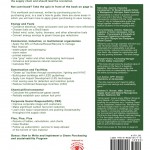Preface from Green Purchasing and Sustainability
Editor’s note: this blog post is the Preface of Green Purchasing and Sustainability, a workbook and manual due out in July of this year. It will detail how to go green and save money in the process. Order information will be available in July.
In late 2009, marketplace research worldwide yielded the fact that despite all the publications advocating sustainable business practices, there was no resource available on how to do it. There were isolated documents, particularly in the educational sector, that touted green purchasing but were rather vague on recommendations. Expressed in other words, every body was yelling about what to do, and no one was explaining how to do it. What is more, it is entirely apparent to anyone conversant in sustainable practice that savings of all most all types constitute sustainability.
Clearly, savings in electricity, fuels, green house gas emissions, natural resources, water, and so forth are sustainable. Savings, whether achieved through reduction, conservation, preservation, recycling, or other means are cost reductions. Cost reductions are the province of purchasing and thus the inviolable contention that purchasing pros can and must lead the green revolution.
Throughout all of 2010, this book was thoroughly researched and vetted. Assistance and input in areas beyond the author’s basic competence was obtained. The result is this assemblage of knowledge, best practices, and proven technologies and methods in all areas of sustainable practice.
The plentiful experiences and extensive savvy obtained from decades in the education and training, seminar, and consulting business have been applied to enhance and enrich the value to the reader of this manual. The many exercises are designed to reinforce the content and provide the practicing purchasing pro with the tools and skill sets needed to develop, implement, and defend any sustainability program.
This publication is a training manual and work book rather than a casual read. As such, ample white space is provided for notes, comments, and questions. Computation space is provided where appropriate.
A basic version of manual is offered in the digital media alternative of online courses. That may raise a question about whether the printed book is in harmony with sustainability principles. As the reader will observe many times, there is not usually one clear cut, unchallenged, and definitive answer.
For example, the debate raging over of “pixel or paper” is becoming more complex with the exponential propagation of data centers. Computer hardware contains toxic substances and troublesome metals. What is more, huge amounts of energy are consumed forever in pixel media whereas paper medial is recyclable.
The book is printed both sides on 100% recycled acid-free paper using water soluble ink. No volatile organic compounds were liberated into the atmosphere as a result of this book’s printing.

